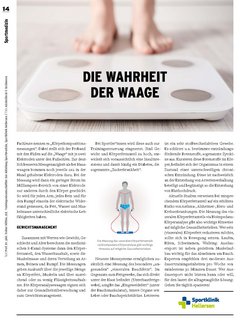WIR IM SPORT 05.2022
Magazine of the Landessportbund NRW
PDF Download
Experts call it "body composition measurements". The test person stands with their feet on the "scales" with two electrodes under the soles of each foot. For significantly better measurement accuracy than with home scales, 2x2 electrodes are held in the hand. During the measurement, a small current in the milliampere range is then sent through the body from one electrode to the other. The electrical resistance is measured individually for each arm, each leg and for the torso, as fat, water and muscle mass have different electrical conductivities.
Weight management
Together with values such as weight, gender and age, the 8-channel medical systems then calculate the body fat percentage, the water balance, as well as the muscle mass and its distribution on the arms, legs and torso. The measurements provide information about the respective amount of body fat, muscles and sufficient or insufficient fluid intake. The body analysis scales are therefore suitable for health monitoring and weight management.
They are also used by athletes to control their training. If weight and body fat percentage are too high, insulin resistance is likely to develop, often leading to diabetes.
The latest measuring systems also make it possible to measure the particularly "unhealthy" "visceral abdominal fat". In contrast to fatty tissue, which is located directly under the skin (subcutaneous fatty tissue), visceral fat (under the abdominal muscles) surrounds internal organs such as the liver or pancreas. The latter is a very metabolically active tissue. Among other things, it releases certain inflammation-promoting messenger substances, so-called cytokines. If these messenger substances circulate in the body, the organism is in a state of subliminal chronic inflammation. This has been proven to be involved in the development of arteriosclerosis and thus promotes the development of high blood pressure.
Current studies point to an increased risk of asthma, Alzheimer's, heart disease and cancer with a corresponding body fat percentage. Measuring the visceral body fat percentage via bioimpedance body analysis therefore provides important information on possible health risks. If you want to reduce your (visceral) body fat, you should get moving. Running, biking, swimming, walking: in addition to targeted muscle building, endurance sports are important for losing weight on the stomach. Experts recommend three moderate endurance training sessions per week lasting at least 30 minutes. If you can't or don't want to do endurance sports, the everyday solution is to go for a walk every day!


